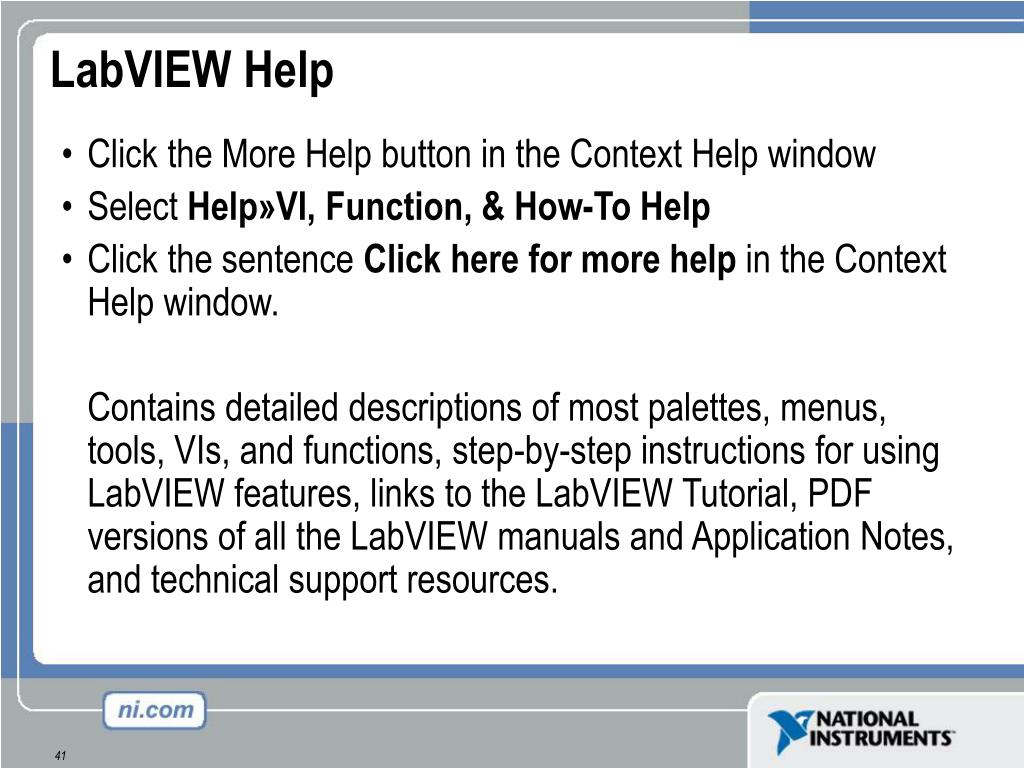

- #Labview 2013 tutorial pdf pdf#
- #Labview 2013 tutorial pdf windows 8.1#
- #Labview 2013 tutorial pdf code#
Windows 8.1 and Windows Server 2012 R2 require Microsoft updates to support these items.
#Labview 2013 tutorial pdf pdf#
You must have Adobe Reader installed to search PDF versions of all LabVIEW manuals.ġ LabVIEW and LabVIEW Run-Time Engine require processors of the Pentium 4M/G1 generation or later, which are capable of executing SSE2 instructions.Ģ NI software installs VC2015 Runtime and. NI recommends that you have several megabytes of disk space available for this temporary directory. LabVIEW uses a directory for storing temporary files. LabVIEW requires a minimum color palette setting of 16-bit color. LabVIEW and the LabVIEW Help contain 16-bit color graphics. Pentium 4M (or equivalent) or later (32-bit) Pentium 4 G1 (or equivalent) or later (64-bit) Pentium 4M/Celeron 866 MHz (or equivalent) or later (32-bit) Refer to the below table to see the system requirements: Windows LabVIEW 2017 System Requirementsįirst, you’ll want to make sure your computer can run LabVIEW 2017. This guide will walk you through the steps for downloading and installing the product. This +-movement of data is known as dataflow programming.It’s another year and National Instruments has released LabVIEW 2017. The movement of data through the nodes on the block diagram determines the execution order of the VIs and functions. and from VIs and functions to other VIs and functions.Data transfers from one control unit to other via wires in the order given below: Controls and indicators are connected via wires and they collectively perform a specified task. Objects on the Front panel appear as icon terminals on the block diagram.
#Labview 2013 tutorial pdf code#
This code uses graphical representations of functions and includes inputs and controls to control the objects in the front panel. Graphical representation of a code is known ad block diagram code. The graphical source code is to be built in the block diagram panel, also known as G code or block diagram code, for how the VI runs. LabVIEW displays two windows: the front panel window and the block diagram window both of them are explained below.

In recent years, due its ease of coding labView have become one of the most popular data collection system. That is why LabView is called a graphical programming language. So, in most LabView programs, no lines of code are written, the functionality of the program is provided by the diagram. Multiple functionalities can be added to the interface in the form of a diagram, similar to a flowchart, “wired” with the various structures and functions. The user interface can be made by simply dragging and dropping objects, and arranging them in a required pattern to complete the path. To create a VI (Virtual Instrument), LabView programming environment can be used.

A program in LabView is called a VI, which stands for Virtual Instrument. LabView is developed by National Instruments sometime in the mid to late 80’s by Jeff Kodosky and it is a graphical programming language.


 0 kommentar(er)
0 kommentar(er)
